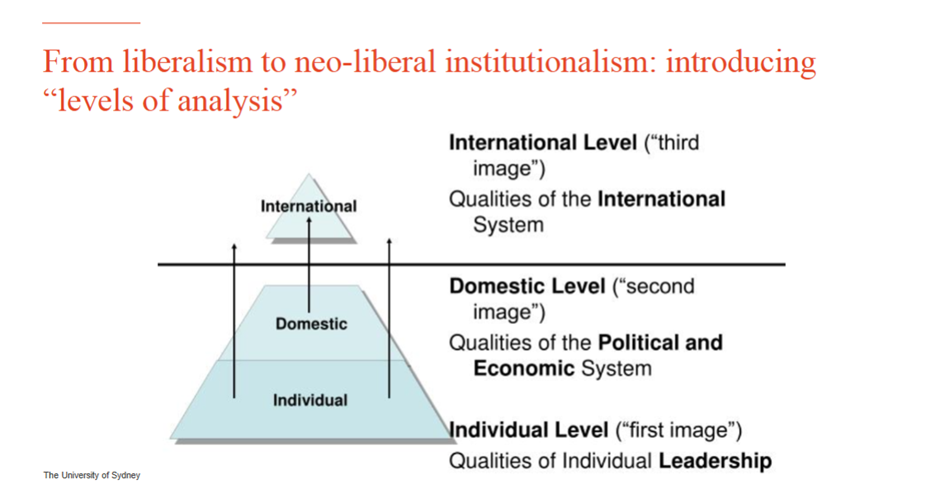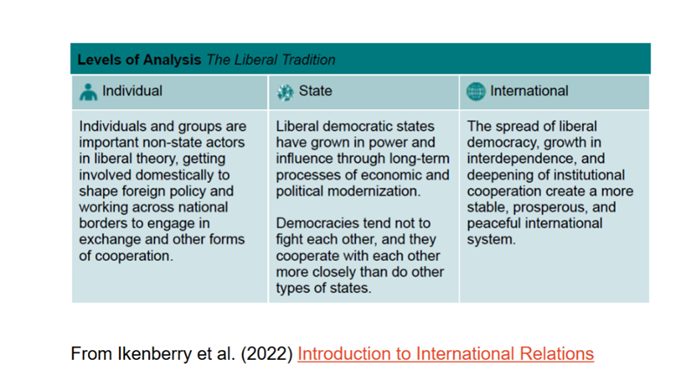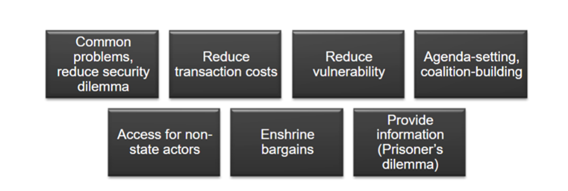Week Four: liberalism
1/19
There's no tags or description
Looks like no tags are added yet.
Name | Mastery | Learn | Test | Matching | Spaced |
|---|
No study sessions yet.
20 Terms
What is liberalism?
Liberalism is the dominant ideology of our age, yet its character remains the subject of intense scholarly and political controversy. It is a very plastic ideology; it can be supportive of free market capitalism (neoliberal economics) or supportive of highly regulated capitalist economic systems (social liberalism). It is associated with the belief that multilateral diplomacy is the only answer to international problems, and it can be associated with supporting “humanitarian intervention” in Iraq in 2003 and Libya in 2011. Liberalism is so flexible it can associate with two sides of many arguments. The reason for this is the malleability of its core concept, freedom. Political freedom has been interpreted in many different ways.
What is the core tenet of liberalism?
Freedom and individuality
Wha are the principal political institutions and ideas associated with liberalism?
: individual rights, rule of law, separation of powers, judicial review, free and fair elections, free speech and free press, open markets and the welfare state. (Lefebvre)
“Its central principles – freedom, (human) rights, reason, progress, toleration – and the norms of constitutionalism and democracy are deeply embedded in Western political culture.” (James Richardson)
Key components of liberalism in IR?
- Opposes the ‘zero sum’ relations between states that realism proposes
§ Belief in mutual beneficial relations, individual human rights and state sovereignty (negotiating benefits nations, hence they will engage in it rather than go to war)
§ Belief in market capitalism and market regulation
§ Associated with democracy, free speech, negotiation and soft power
§ Support for multilateralism, interdependence and International Organisations
§ Support for freer trade, open communication and globalisation (mutual benefits can be part of international relations)
§ This adds up to three stands of Liberal IR:
o Liberalism with a focus on economic independence particularly through trade (IPE);
o Liberalism with a focus on democratic peace;
o Liberalism with a focus on law and International Organisations (Ikenberry). Liberals don’t see nations in a general state of war and believe security is not always the central concern of individuals or states.
What are the major developments of the International Liberal Order?
The major developments
1. Wilson’s 14 points in 1919 and the creation of the League of Nations
2. The Atlantic Charter, the creation of the UN and the Bretton Woods
System
3. "We shall pay any price, bear any burden, meet any hardship, support any friend, oppose any foe to assure the survival and success of liberty.“ President John F. Kennedy, Inaugural address, January 20,1961
- JFK’s speech on the success and survival of liberty, a common theme of US Presidency speeches.
Ikenberry;s theories on Liberalism?
1. American created this order through strategic restraint, binding cooperation and
enlightened self-interest after WWII
2. System of international institutions, rules and norms created the liberal international
order
3. Opposes realist mindset of power politics or rule of authoritarian states
4. Ikenberry claims the order is not perfect but better than any other alternative
5. Critics from the Left have asked when was this order truly “liberal” and when was it
truly “international” or truly “rules bases”; Realists have criticized its overpromotion
(rhetoric not reality), overreach, and naivety; Conservatives like Trump argue it leads
to America being taken advantage of (NATO nations suck from US security but don’t contribute enough – nations take all the benefits of US free trade but protect their own industries with subsidies and etc, with the net benefits trickling out of the US and giving them a negative trade balance).
The levels of analysis in international relations?

What is the individual level>
Scholars who look to the individuals (ontological question)
What is the domestic level?
The agents within the state, like economic factors, the arrangements of power and within the state level analysis
What is the international system?
The anarchic of soverign equivalent states and what it targets when it seeks to understand or explain what it targets when it seeks to understand or explain what’s going on
Levels of analysis in the international system?

Heuristic meaning:
not directly distinct and do have overlap. Can be used to analyse where others are focusing their analytical gaze and allows us to be conscious of what image we have of the political state of the world (eg individual, domestic, international) and how this influences our politics. Note this is very hard wired into IR so it’s important to always keep in your mind the ‘images’ of analysis.
Liberalis is typically concerned with the domestic, meani
views it as the shaping factor and motivator of foreign policy. For example, the theory that democratic nations don’t go to war with eachother is a ‘domestic image’ because it’s their internal political system. (known as Domestic Peace Thesis)
Main difference between liberalism and neoliber
o Classical liberals inform new ideas and ways of thinking, which leads to ‘neo’ liberals.
§ These people were looking for new ways of liberal thought in politics
§ Ultimately the defining factor that separates the neo from the classical is the shift in image focus – neoliberalism focuses on the top, or rather the international image.
What is the concept of interdependence?
Keohane and Nye’s (1977) Power and Interdependence: World Politics in Transition.
Still embedded in liberal tradition and concerned with “second image” as well as “third image” analysis.
Interdependence: “mutual dependence”; a situation “characterized by reciprocal effects among countries or actors in different countries” (K&N 2012 [1997], p.7)
effects among countries or actors in different countries” (K&N 2012 [1997], p.7)
Interconnectedness: a situation characterised by interactions that “do not have significant costly effects”
(K&N 2012 [1997], p.8)
Ultimately, the thesis states that nations become enmeshed and more enmeshed to each other by creating new binding treaties and will change their functioning behaviour in the IR system.
What is the role of institutions for liberalis?
- Important sites of power and mutually beneficial to states in the international system. Create huge benefits for all involved states and allows them to develop solutions to common problems and reduce the risk of a security dilemma
o Security dilemma: one state takes action to solve a problem, which is then perceived as a threat by another state which might take action and just lead to retaliatory effects

Key insights of neo-liberal institutionalism?
- Goals of actors vary by issue area.
- International institutions are important agenda-setters, induce coalition-formation
- Not only military (‘hard’) power (‘soft’ power = influence/ideology)
- Cooperation can be a rational policy instrument.
- Agenda formation dependent on power resources within issue area, on international cooperation, on issue linkages
What is the democratic peace thesis?
• Democratic peace theory is first set out by Michael Doyle (1983, 1986), it challenges the realist claims that peace depends on the systemic balance of power rather than the domestic nature of governments.
• Liberal states ‘claim that governments founded on a respect for individual liberty exercise "restraint" and "peaceful intentions" in their foreign policy’
• ‘Liberal states are different. They are indeed peaceful [among themselves]. They are also prone to make war [with non-liberal states].’
• citizens appreciate that the benefits of trade can be enjoyed only under conditions of peace. Thus the very existence of liberal states, such as the U.S., Japan, and our European allies, makes for peace.’
[Peace among democratic states...but not with autocratic states...]
‘Even though wars often cost more than the economic return they generate, liberal republics also are prepared to protect and promote—sometimes forcibly—democracy, private property, and the rights of individuals overseas against nonrepublics, which, because they do not authentically represent the rights of individuals, have no rights to noninterference.’ [liberal imperialism]
• Liberal Democratic Peace Thesis argues that first, democracies are committed to the
principle of resolving political differences nonviolently, and they adhere to this in their
relations with other democracies no less than in their internal politics. Second, the
publics in democratic societies, who would bear the cost of war, are unwilling to
support such action against another democracy.
• Democratic Peace Thesis: “No one should argue that such wars are impossible; but
preliminary evidence does appear to indicate that there exists a significant
predisposition against warfare between liberal states...a liberal zone of peace, a pacific
union, has been maintained.”
• Why no peace with non-Democratic states...“To simplify greatly, if the explanation for
the separate peace between liberal states is due to their liberalism, it is tempting to
argue that relations between liberal and non-liberal states cannot be peaceful, for the
latter are, in a sense, at war with their own people.”
• US “unwilling to accord non-liberal states the same degree of respect that they give
to other liberal states”
What is Fukuyaama’s main argument in The End of History and the Last Man?
Fukuyama's Thesis: History is moving toward an "end point" — a world dominated by liberal democracy and capitalism. This system, he argues, best satisfies two fundamental human desires: for material prosperity and for recognition (a core Hegelian idea).
Normative Claim: Liberal democratic capitalism triumphed in the Cold War not just practically, but because it fulfills deeper human needs (freedom, equality, recognition), unlike other systems (e.g., fascism or communism).
Levels of Analysis:
Level 1 (Fukuyama): Human nature and universal desires drive political convergence.
Level 2 (Doyle): Focuses more on democratic peace theory and institutional factors.
Critiques:
Oversimplification: Critics say Fukuyama underestimates complex realities like China’s rise — it’s economically capitalist but politically authoritarian.
Conservatism in Disguise: Though Fukuyama promotes liberal democracy, he laments its “dullness.” He worries that a world ruled by isothymia (equality-seeking) may suppress megalothymia (the drive for greatness and superiority), leading to a bland, non-heroic society.
“Whig history” Narrative: He sees a teleological progression toward liberal norms, citing increases in liberal democracies and decline of wars among them.
Ultimate Message: Fukuyama isn’t entirely celebrating liberal democracy — he’s also concerned that in achieving equality, we may lose excellence, ambition, and the richness of historical struggle.
Joseph Nye’s ‘Soft power’
Develops concept that what world politics has arrived at is a recognition by great powers that they’ll be much more effective if they use soft rather than hard power. IE Nuclear weapons is not very coercive
- Soft power is the use of persuasion, attraction and co-option to win over foreigners (global public opinion) and other nation-states. A mix of both deliberate means and parts of society (foreign aid, EG aid to Ethiopia comes with a USA flag)
- Achieved via government-to-government diplomacy and public diplomacy; through the spread of a state’s values and foreign policy goals. Through foreign aid (the case of USAID). Also via the spread of a nation’s popular culture internationally. Like South Korea and KPOP.
- Successful soft power conversion requires having an available and receptive audience and playing your hand well. It is about both the supply of, and demand for, ideas and culture from elsewhere.
Also consider Viet Than Nyuyen – the use of propaganda is also effective (eg Vietnam war). The more naked the propaganda, the less effective. Realists argue that this isn’t really a tool.